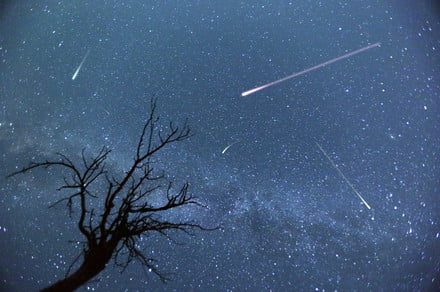cylonphoto/123RF
If your weather cooperates this weekend, look up towards the constellation Perseus. Why? August 11-13 is the expected peak of the Perseid meteor shower, traditionally one of the best celestial shows of the year. With it being a new moon, natural light pollution is at a minimum, allowing more meteors to be visible.
While astronomers are not expecting a massive burst like they did in 2016 and 2017 due to passing through multiple debris streams of the Comet Swift-Tuttle (the source of the Perseids), the moon phase is in our favor. At its peak, as many as 60 to 70 meteors per hour may be visible, with brief bursts much higher than that.
Observers may see quite a few meteors Saturday night into Sunday morning, however the better show may be Sunday night into Monday morning according to NASA meteor researcher Bill Cooke. You’ll want to look towards the constellation Perseus, which will be high enough in the sky starting around 11 p.m. local time to just lie down flat and look straight up to see the show.
[youtube https://www.youtube.com/watch?v=kBiIV97wA2w?feature=oembed&w=100&h=100]
Why are the Perseids such a reliably good show? Comet Swift-Tuttle last passed by Earth in 1992, and will do so again in 2126. Even with such a long orbit, the comet’s large size allows it to leave a far denser debris trail behind it than others. The nucleus — the comet’s icy, rocky core — is some 16 miles across, larger than Staten Island in New York City, and almost twice the size of the object that is believed to have smashed into the Earth 65 million years ago, killing off the dinosaurs.
Don’t panic: Swift-Tuttle is in no danger of striking the Earth anytime soon. Most of these meteors are tiny, posing no threat to us here on the ground. However their breakneck speed — some 132,000 miles per hour — causes even tiny specks of dust to illuminate as they reach temperatures upward of 10,000 degrees Fahrenheit during entry into our atmosphere.
Paul Williams/Flickr
You can tell what the meteor’s made of by the color of its trail: orange-yellow is typically sodium, yellow is iron, blue-green is magnesium, violet is calcium, and reds are caused by nitrogen and oxygen. In the right conditions, meteor showers like what’s expected this weekend can be pretty cool.
But like weather, predicting meteor showers is an imperfect science. Minor miscalculations in where the meteor streams can mess everything up. There have been years where the Perseids have disappointed from time to time (and also surprise, too), and issues such as cloud cover and light pollution also pose a problem.
Weather may pose the biggest problem, especially east of the Mississippi and over the Southern Plains. The best views this year appear to be in the Pacific Northwest and Great Lakes States, with less prime conditions across the Southwest and Southeast. If you’re in the Northeastern U.S., viewing this year’s show will be difficult thanks to clouds and storms that could persist through much of the weekend.
As for light pollution, you’re going to want to get as far away from urbanized areas as possible, otherwise you’ll miss a lot of the smaller meteors. Also keep in mind you’ll need to give your own eyes about 20 minutes to fully adjust to the lower light.
Editors’ Recommendations
- A Japanese startup is planning an artificial shooting star show by 2020
- Canon’s new large sensor is too big for you, but not for scientists
- The best dash cams
- How to use Split View on a Mac
- Google Street View gives woman a special gift — an image of her late mother

